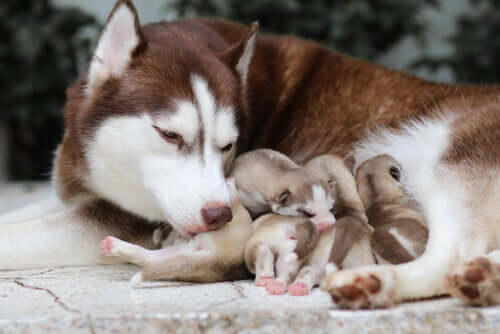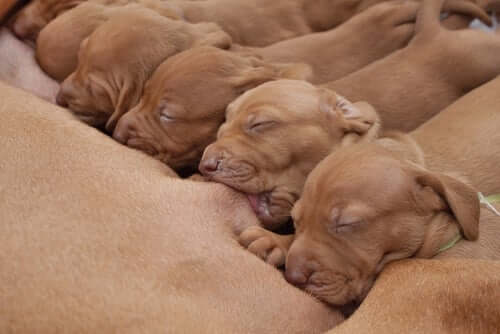What Is Canine Puerperium?


Written and verified by the lawyer Francisco María García
The canine puerperium is the moment immediately after a dog gives birth. Therefore, it’s the time it takes for the body to rearrange its organs and hormones.
Although animals have instincts when giving birth, helping them will make it faster. In addition, there will also be a smoother recovery.
It’s common to give all of the attention to the litter after the birth. Everyone is so excited to have puppies! However, don’t forget about the dog and the care it needs to take care of its young. The calmer and healthier the mother is, the better the condition of the puppies.
Basic care during the canine puerperium
Hygiene
For starters, immediately after delivery, make sure you clean the dog thoroughly. Also, clean the place where she gave birth to the litter.

With a warm, damp cloth, clean the dog’s face and body. Get rid of the blankets where she gave birth. Additionally, get rid of any residual blood, placenta and other debris like feces or urine.
In this sense, hygiene reduces the risk of infections in the mother and puppies.For example, coccidiosis is a disease from parasites that reproduce in animal feces.
Contact with fecal matter transmits coccidiosis. In fact, this is very common in puppies, and by cleaning the space where the litter will be, you reduce the risk of infection.
Health
In the canine puerperium, the mother is exposed to infections. Therefore, it’s important to monitor her health and mood.
It’s normal for dogs to be tired and sleepy at first. In fact, she might even sleep more than usual. Although she will feel uncomfortable, after each nap she should be active and in good spirits. However, if the opposite happens, it could be the result of an infection. In addition, it could mean there’s a problem with her hormones.
Another sign of infection might be a fever. Some symptoms of a fever are hot dry nose, watery eyes, lethargy, poor appetite and tremors. In this case, you should go to the vet immediately.
Food
During the canine puerperium, food is essential. Not only should it be a balanced diet, but also make sure that she’s eating enough. Right after giving birth, they usually eat three or four times a day. This can last up to three weeks after giving birth.
In fact, puppy food is a great choice because it’s high in protein and carbohydrates. Staying hydrated is also important because water helps produce breast milk.
Breastfeeding in the canine puerperium
It’s important to monitor their breasts during this period. It’s not enough to just make sure they are producing milk. You should check to see if she develops eclampsia or mastitis.
Any infection the mother has contaminates the breast milk. Therefore, it could end up poisoning the young pups.

Medical services
After giving birth, the dog needs to go to the vet. There, they will check her health. The specialist will also make sure that she delivered all of the puppies and placenta to prevent metritis.
Other elements to consider during canine puerperium
There are other factors that are important to monitor during the dog’s postpartum recovery.
Lochia
During the next 15 days, it’s normal for the dog to get rid of fluids called lochia. This is the result of the detachment of the film that covers the dog’s uterus. Lochia should be odorless and greenish-brown or blood red.
However, if the fluids smell bad or look wrong, call the vet immediately. In addition, you should also call the vet if it lasts for more than 20 days.
Attention to puppies
We should also mention that it’s important to make sure the mother cleans her puppies after delivery. That way, they’ll be able to breathe correctly.
If the mother doesn’t lick her pups, wipe their face and muzzle with a damp cloth. They will also need warmth for their bodies to activate.
This text is provided for informational purposes only and does not replace consultation with a professional. If in doubt, consult your specialist.